
Copyright © All rights reserved.






Ecuador & Galapagos (2014)
In September 2014 I went to visit Ecuador; to get to know the country and the people, but also to try and learn some more Spanish. After some research, I found a Spanish school in Baños, Ecuador, which offered the possibility to combine Spanish lessons with traveling the country, using public transport, and staying with local families. Perfect to learn Spanish and ideal for my first time in Latin America!
As I was already going to go all the way to Ecuador, I decided to extend my stay visiting the Galapagos island, a lifelong dream of mine. In the spirit of getting to know the country and its people, I chose to explore the Galapagos islands by island hopping and staying in local hotels rather than going on a cruise. (In retrospect, both options give you very unique possibilities to explore the islands. If time permits, I would recommend everybody to combine both.)
You can also find my trip report on Ecuador & Galapagos on www.blogger.com!
Spanish School in Baños: "Raíces" Spanish School
German travel agency: lernen und helfen sprachreisen
Itiniary / GPS Track
Quito -
Approaching Quito
Flying to Quito via Amsterdam. Short connection time in Amsterdam, and of course my flight to Amsterdam is delayed. Leaving the plane when boarding is supposed to start. However, this still doesn't seem to be short enough to get into the the short connection lane at the passport control. When I finally get to the gate, I see it's not a problem, the line for security check is still huge. An hour later I finally get into the plane, and we take off (also a bit delayed).
After almost 11 hours uneventful flight, mainly over water, we are approaching Quito. The view on the surrounding mountains is astounding. Although Quito itself is already at an altitude of about 2900m, if feels like flying into a valley. We land on the new airport of Quito, which just opened one year ago. (The old one in the city has now been transformed into a park.) Although the airport has been open for a year now, the street going there was just finished about a month ago.
Quito's architecture (at least in the old town) is typical Spanish from the colonial time, although it actually has a history much older. Being the captital of the kingdom of the Quitos, it was first taken over by the Incas, and then, just after a few years when the Spanish started coming, was burnt down by the Incas, instead of leaving it to the Spanish. Those then built a new city on the ruins of the old one.
Quito has lots of curches and monestaries, each if the beautifully and richly decorated. With the Ecuadorians being very religious, services are ongoing in all the curches most of the time. Around the main square (square of power), apart from the cathedral, there is the bishop's office, the mayor's house, and the president's palace. (The vice president's palace is just around the corner.) On one of the many hills in the city, a big statue of the Virgin Mary is overlooking the city. From here I also have a nice view of the city, and it becomes clear how large Quito actually is.
In the north of Quito, a big monument mark the equator (although GPS says the equator actually is about 200m further north). A samll museum in the monument gives a first impression into the many different cultures living in Ecuador. Around the monument, a small town has been created, only consisting of tourist shops and restaurants. I can only imagine how full it might get here in peak season.
After only one day, it is time for me to say goodbye to Quito...
GPS Track / Mainland Ecuador
GPS Track / Galapagos Island Hopping

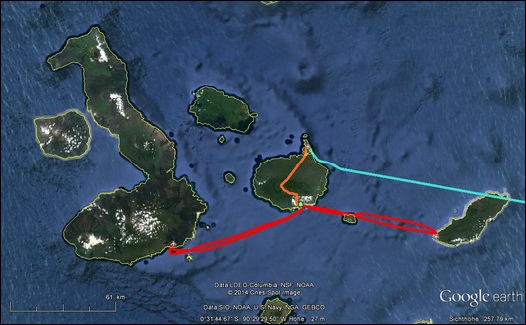

Colonial Center of Quito
Traveling to the Finca
It was time to leave Quito. After finding the right bus and my seat, I first felt like being in a travelling road show. Right from the start I guy started praising his goods (watches, sunglasses, jewelry, ...) and handed them around to look at (and of course to hopefully buy). He eventually did leave the bus, but by that time, at every stop, seperal people came into the bus, trying to sell water, fruit, ice cream, , and basically anything else I could think of. Most of th just came in shortly during the stop, other stayed in for a stop or two. This way the trip to Santo Domingo could take ages...
After finally leaving the greater Quito area, things started to calm down. For over 50 km, there was no stop, just a windy road going constantly downwards. After all, we had the get from an altitude of about 2900 m down to only around 400 m. (Glad that the brakes worked well on the bus!)
At first, we were mainly in the clouds, however, as we came further down, I could see the vegetation changing into rich green ferns, palms and lots of bananas.
After 3 hours, we finally reached Santo Domingo, where I was picked up by my teacher and host for the next couple of days. By car, we vntinued the trip to the next small town, and from there another 20-
At the Finca
My home for the next couple of days was going to be the finca, a typical banana farm in the coastal region of Ecuador. I was staying with Juan Carlos and Chari, the owners of the farm, and their three kids. Additionally, the family had three dogs and many chicken running around, as well as a parrot up in the mandarin tree (unless he was being fed or the daughter played with him). A big wooden shed contained kitchen and dining area, which was also regularly visited by members of the other families living and working on the farm (including their dogs) or relatives living in the nearby village, which often came to help out as well.
The food prepared was typical for the coastal region, and apart from rice and bread, was mainly from the farm itself. Typically, any food served always is rice plus something else. This something else could be vegetables, meat, eggs, cheese, ... In my familiy the rice generally came with platanos (green bananas for cooking), cheese, eggs and a variations of other vegetables and fruit growing on the farm. For lunch, additionally a soup was servered. Breakfast for the workers was similar, for the others fresh fruit, eggs and bread with cheese. Additionally, there was always freshly pressed fruit juices available.
On my first day on the finca, I got a tour of the farm, to see the different types of bananas being grown here, but also some of the many other plants, being used only by the family, not for export: papayas, kakao, pepper, yucca, mangos, lemons, oranges, mandarins, watermelons, cinamon, and many other exotic plants, whose names I have already forgotten...
The other day, I got a first glimpse into what I might expect at my next destination, in the jungle. The nephew of my hosts showed me around in a small jungle they had at the edge of the farm. It didn't have any preprepared tracks, so we had a machete with us to clear the way. Again, I got shown lots of different plants and explained their use (for eating, for making jewelry, for building houses, for their colour), as well as many different types of ants and termites and their different types of housing. We also talked about the different animals generally active at night, and why it therefore wouldn't be such a good idea to go for a stroll in the jungle at night (unless you want to be bitten by poisonous snakes).
All the explanations I got, however, as well as any other conversation on the finca, was always in Spanish (meaning I definitely didn't understand everything). Except Juan Carlos, nobody spoke any word of English. (And even Juan Carlos only understood a bit of English, but didn't really speak much either.) But after all, I was here to learn Spanish...

The Finca / Banana Farm
On the Bus
After two days, it was time to say goodbye to my family at the finca, and start my journey into the jungle. From Santo Domingo I took the bus to Ambato, where I met the dad of the family I was going to stay with in Baños. Together we continued on another bus to Baños, from where I took the bus to Tena, a small town at the beginning of the jungle, the next day.
The bus rides were generally similar to my first one to Santo Domingo, however with more stops on the way, and much more people travelling. Therefore I could nicely observe, how the bus system worked here in Ecuador.
Generally, buses seem to connect most towns on a quite regular basis, and are a well used transportation system, as many people don't have a car. There are many different bus operators available, trying to get people to use their company. Therefore at every bus terminal, but also at the important stops on the street, the conductors are shouting out their destination loudly.
When buying my ticket at the station, I was assigned a certain seat on the bus (which, depending on the operator, was also checked). However, all the people getting on the bus at all the intermediate stops just took any available seat or, if the bus was already full), stood in the aisle or entrance area (sometimes also including lots of bags).
The busses do have some fixed stops (sometimes they also call out the name of the town, but not always), but will also stop (or at least drive slow) wherever somebody wants to get on or off.
Again it was common, that at every possibility, people came in, trying to sell stuff. Apart from the typical things (drinks, snacks, sunglasses, watches, ...) I also got to listen to the dangers of skin cancer (of course you could buy the appropriate cream to prevent it), listen to loud music for a while (of course you could buy a copy of the CD), and was told in which hotel I should come and stay (of course the woman next to me on the bus ran this hotel). And as additional entertainment (if the scenery and the people on the bus weren't enough), usually a movie was shown.
Then, after more than 8 hours on busses within two days, I had finally reached Tena, for my jungle experience.
In the Jungle
In Tena, I was picked up at the bus station by a local Indio family. The family runs a small tourist company and owns a few cabins here in the jungle. After collecting food and candles from their home in Tena for the next days, we first continued by car for half an hour (first on a normal road, later on a dirt road) to the house of their parents, and from there another 15 minutes by foot into the jungle to the cabins close to a big river. (The rubber boots I was given fory time here in the jungle were very useful for the track to the cabins.)
The 'jungle lodge' was very simple. No electricity, no telephone, no internet. Light came from candles (or torches) and a big fire was lit for cooking (or the gas stove was used). No shops anywhere close to buy food (or souvenirs). A standard toilet existed, however no proper shower. Everthing was built with plain wood, and was basically open, just covered by a roof against the rain.
Shortly after arrival, I went for a walk through the jungle with my guide for the next days, Enrique, also part of the familiy. He showed me lost of different plants in the jungle, and what they are used for, especially all the natural medicine the Indios have used in this area for a very long time, as well as plants used by the shamans, causing hallucinations (including detailed explanations how I would need to plepate them). We ate some fresh fruits directly from the tree (e.g. cacao), but I also got to try what he called the jungle peanuts: large ants (a bit smaller than peanuts). (For my taste not really bad, but also nothing special I need to have again.)
Otherwise, the food here in the jungle was a bit different to what I had experienced at the farm. For the first time here in Ecuador, I didn't get rice forvevery meal (rice doesn't really grow in this area), but lots of yucca, which can be found everywhere in this region. Otherwise it was not so different, bananas where also growing everywhere, and chicken were running around. In the nights and mornings, Enrique also went out to the river to fish. However, as he only caught very little, I didn't get to try them.
Unfortunately, the next day it rained all day. We still started to go for a walk (rain in the jungle is not really unexpected). However, it had rained so much that the rivers had risen quite a lot, and the path to visit some waterfalls was no longer usable. At least, because if all the rain, I did get so see a small frog on the way. (I decided to better leave it where it was, as the skin is quite poisonous.)
The next day, the weather had cleared up, and so we went for another walk, this time to a natural pool for a swimm. A smaller river had formed a few small ponds before joining the big river through a few smaller waterfalls. The area of the ponds was in a 'tourist center' with generall cost an entrance fee. As we arrived, however, the whole thing was closed. (We found out later that there was an accident just two weeks ago, where a kid of a politician got caught in the strong current and got into the waterfall and unfortunately died. That's why it was closed to tourists for a month.) We, however, as all the other local people, just went around the gate to get in. In one of the ponds, a school class was being tought kayaking, and lots if smaller kids and mums watched. We then went for a swimm in one if the other pools. It being a really warm and sunny day, the clear water felt really nice and refreshing.
In the afternoons, I had my Spanish lessons, but also had time to look around a bit, at all the birds, insects and butterflies around (not so much interested in the large cockroaches or spiders) and to take photos.
After dinner, in the candle light, I got to learn a card game typically for Ecuador, Cuarenta (Forty), and enjoying the sounds of the jungle.
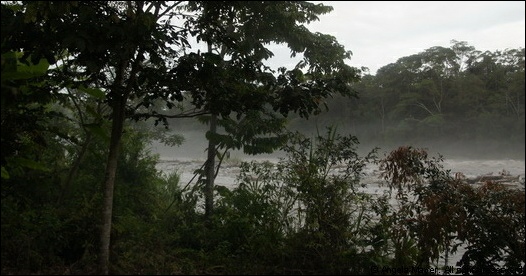
Selva / Jungle
My family in Baños
After my time in the jungle, I came back to Baños, where I would stay for 5 days with a family, go to school to learn Spanish, and explore the area around Baños.
Baños is a small town, quite popular for tourist from all over the world (including from Ecuador). It's directly next to an active vulcano, still lies in the mountain region of Ecuador, but is also called the gateway to the jungle. Being in the region of the cloud forrests, the is also lots of water and therefore (because of all the mountains) also many waterfalls around. Because of all the waterfalls, rivers and canyons, it's also very popular for any kind of adventure sports: canyoning, rafting, ziplineing, bungee jumping, mountainbiking, ...
The familiy I stayed with was really lovely and took me in, almost as if I were a part of the familiy. The family, that were the parents, Gina and Roberto, and their three kids, Jessica, Marco and Lissi. But most of the time it seemed that the familiy was actually much larger, as most of the time friends or relatives came to visit. Especially one neighbor kid (also cousin) in a similar age of Lissi (around 8-
Apart from hosting Spanish students, the familiy earns their money making maracas, jewlery and other souvenirs. Like most people in Baños, they live from tourism. On Sundays, Gina has a stall in the Parque de la Familia to sell here work. However, most of it gets exported as souvenirs unto other countries, like Peru, Bolivia or Cuba (as 'original' souvenirs from there).
We also went to visit Gina at her stall (where I got a small maraca with my name as a present), and then explored the Parque de la Familia with Roberto and the kids. The parc is really beatifully made, showing the different plans and flowers typically in the area, as well as greeting areas for typical animal like chicken, geese, rabbits, guinea pigs and fish living in the surrounding rivers. Additionally, from the parc, it was possible to get a nice view on the hydroelectric powerplant, which supports the whole region with electricity.
Another day I took a bus tour to visit the 'Ruta de las Cascadas', the route of the waterfalls, which is the first 20 km of the street to Puyo (and Tena). Nowadays, the street is in very good condition with many tunnels. Not so long ago, however, it was considered one of the most dangerous street in Ecuador, as it was a small dirt road along the edge of a canyon, without any security on the side, but with lots if traffic (including many buses and trucks). (With the new road, the travel time from Baños to Tena was reduced from 8-
In the evening we took a chiva (mixture between truck and bus) up to a viewpoint over the city. Especially on the weekends, this seems to be quite a party tour. The chiva was lit up with many disco light, and salsa music was playing as loud as possible. On the top, after enjoying the view for a bit, we were first served a warm alcoholic drink (the nights in Baños were quite cold), and then got to see a fire and comedy show (unfortunately it was all in Spanish, and I really didn't understand much).
On the next afternoon, we then also hiked up to the same outlook, again with Roberto and the two little kids. The bit up until the viewpoint was quite steep, but after enjoying the view and recovering a bit, we decided to continue for a bit further. We came by lots of plantations of tamarillos and tomatos, a chicken farm (the smell wasn't so nice), cows and horses. The view down the valley was quite beautiful. What we weren't aware of was that the path we were on (actually a road) would take about 2 more hours from the viewpoint to the 'casa del arból', a tree house on top of the mountain. As we only started the hike after lunch (we had school in the morning), it was starting to get quite late. Just as we were about to call it a day and turn around to head home, a pick-
Much too early I had to say goodby to 'my' family, as my two weeks on the mainland of Ecuador were almost over, and I was heading back to Quito.
Baños -
Baños -
The first two days in Baños, I wasn't quite sure what to believe. When people showed me the direction to the volcano, I just saw two smaller mountains, both not really looking impressive, and definitely not like a volcano. Finally I saw what was hiding in the clouds the days before, a high volcano, the top covered in snow, smoke coming out of the top.
About fifteen years ago, the volcano started being very active again, and Baños, being so close to it, was evacuated was several month. Fortunately, in all the erruptions back then, nothing was actally destroyed in Baños, the town seems to have been saved by two canoyons, in which the lava flew. (Also, several villages on the other side of the volcano were destroyed.) Unfortunately, however, this evacuation cause lots of other problems, as people couldn't work, and therefore couln't earn money for many months. And even when the first ones returned, there were no tourists because of the evacuation (and most people in Baños live from tourism).
For that reason, nowadays, the people of Baños have fought with the government, that in the future, evacuations because of the volcano are voluntary, people do not have to leave it they don't want to. And most people will rather stay...
But the volcano is part of the everyday life of all people living in Baños, or even just visiting. Everywhere in town, signs show the evacuation routes (as anywhere else in Ecuador close to a volcano). Police and army are around, keeping close watch of the activities of the volcano. Whenever a loud noise, people look up to the volcano to see if a cloud of ash comes out or even lava. During my stay, I did hear it from time to time, saw ash coming out once, but no lava. And we even had a small earthquake as well, which also seems to be rather normal.
One afternoon I went to visit one of the canyons, in which generally the lava flows. I went up the hill on horseback (gladly my horse, Chocolate, was basically an automatic horse, it know where to go ...). The (cold) lava we saw was only a few months old.
Next to the lava canyon was a small pond, where I could see a few bubbles coming up. When tasting the water, it was like drinking mineral water with gas. Also this was a side effect of the volcano.
Another side effect, which also gives Baños its name, are the hot springs in the area, which are nowadays used as public swimming pools. One night (unfortunately it was a Saturday night) we thought it a good idea to go and visit as well. It being Saturday, we weren't the only ones with this idea, especially as many tourists from other parts of Ecuador seem to come to Baños over the weekends. All the pools (except the one with the cold water) were packed, with already many people waiting next to it for a chance to get it. I've never seen a swimming pool that packed before. It didn't really seem to bother the other Ecuadorians, we, however, decided to go back home instead.
And the people from Baños keep on living next to their active volcano, Volcán Tungurahua ...

Baños de Agua Santa
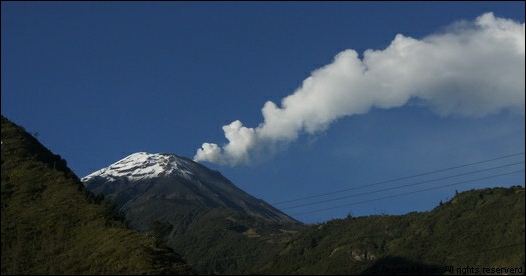
Volcán Tungurahua
Indio Market
One of my days in Baños, instead of school, I had the opportunity to visit an Indio market. Every Thursday, the little town of Saquisilí, about half way between Quito and Baños, becomes very busy. Unlike the well known market in Otavalo, which nowadays is focused a lot on tourists, the market in Saquisilí is still from Indios for Indios, and people from the whole region come to sell or buy.
This way it was also possible to see the different traditional cloth of the Indio peoplevin Ecuador. Basically every community has a different way to dress (including a different hat), and quite many people actually dress in the traditional way every day as a standard.
Basically the whole town of Saquisilí is a market on Thurdays, although there are some main areas. At first I went to the animal market, as it closes the earliest. It's the market for all big animals. You could buy cows, sheep, pigs, lamas and donkeys, of any age or size. Next to it was a small food area, and you could see people eating there, with their new sheep on the leash next to them. The animals then were just loaded on the back of pick-
On another place in town, all the smaller animals were for sale: chicken (and chicks), doves, rabbits, and of course guinea pigs. Those kind of animals were usually sold in large quantities (especially the guinea pigs), usually for some kind of big event, like weddings.
The area, where meat was sold, was actually quite small, I guess most people would rather buy their meat still alive. Fish, however, were not sold alive (except for a few crabs and similar). The fish were mainly freshwater fish, out of the many rivers in this area. (Both for meat and fish, however, cooling seemed to be non-
In other areas, any kind of fruits and vegetables were sold (especially lots of mandarins, potatoes and yuca), as well as add different sorts of grains (especially rice and all different types of corn).
But not only good could be found on the market, basically everything was sold there: cloths, flowers, baskets, all different kind of metal parts, beds (including matraces), sofas, doors, ...
Leaving Saquisilí, we could see all the fully loaded pick-
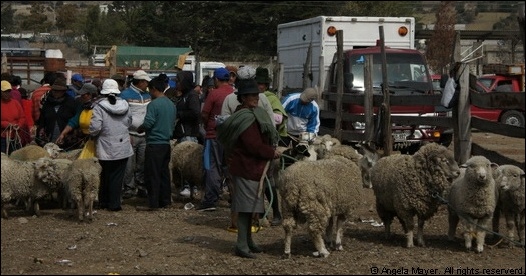
Animal Market -
Cotopaxi -
After almost two weeks in Ecuador, I had to head back to Quito. Since the Panamericana Highway in this area is also call the Route of the Volcanos, I had decided to visit one of them on the way, the volcano Cotopaxi. Therefore I left the bus from Baños at the highway exist going to the entrance of the Cotopaxi national park, where I was picked up by my guide for the tour. (Another German tourist also waited there, hoping to find a tour he can join, so he came with us as well.)
Cotopaxi is one of the highest active volcanos in the world, with over 5890 m. (But not as active the the volcano in Baños. The last erruption at Cotopaxi was about 100 years ago.) The entrance to the national park is at about 3000 m, and it is possible to get up to about 4600 m by car. The road is only a dirt road, with some quite had patches. Additionally, the snow starts at about 4200 m. From the end of the road, it about another 300 m in altitude to the base camp. From here, it seems to be possible to climb up the top in about 6 to 8 hours. (Usually the climbers would start around midnight, to get up the top around sunrise.)
I had only planned to get up to the base camp. However, since I had spent the last week in Baños with only about 2000 m altitude, I had to get up very slowly and carefully, not to get the altitude sickness.
Usually, before going up that high, you should aclimatise at around 3500 -
The weather was quite crazy this day. When starting in Baños in the morning, it was all covered in clouds, which came quite far down. Just as I was getting closer to Cotopaxi, the bottom clouds cleared up a bit, so I could see the whole volcano, up to the top. During the hike up, the clouds started closing in below us. From the base camp, I could therefore only image how the view from up there would be. Heading downwards, for a short moment, the sun actually came out (for some dice views and photos), before it then started snowing / raining ice on the last bit back down to the car. Heading further back down with the car, the snow changed into rain. I then didn't really see much of the rest of the park, as it continued raining quite heavily for the rest of the day. I did, however, very shorts see some wild horses, a falcon and a fox.
In the end, I was brought back to the highway exist, from where I caught a bus to Quito. As I had gotten up really early, was going to get up really early again the next day, and as it was also raining in Quito, I just went into my hotel, and had a hot shower after all the snow on Cotopaxi.

Volcán Cotopaxi
On the Way to Galapagos
Eventually, my two weeks in Ecuador (mainland) were over, but I still had a week on the Galapagos Islands in front of me.
Again, I had to get up quite early in the morning to catch my flight. (The new airport in Quito was about 1 hour from my hotel.) For all flights to Galapagos, you have to buy a tourist card (for 10 dollars) before you get on the plane, and you have to get your bags checked for any food, plants, seeds, ... (things that could harm the environment on the islands). Then your bags get sealed. (Not always perfectly sealed, depending on the bag. On mine, 2 out of 3 zippers remained open. I guess it's more about the general idea...) Only after this can you actually check in. As I was told several time that this process might take quite a while because of long queues, I was at the airport quite early, 2 hours before the flight. After less than 10 minutes, all was done and I was waiting for my flight. (Although after I was through, I saw that more and more people started queuing up.)
All flight from Quito to Galapagos seem to go via Guayaquil, as did mine. The first part, southwards from Quito, along the Andens, I had a really nice view in all the volcanos along there. As we were heading more towards the coast, it started to become cloudy, and the rest of the flight to Guayaquil and further on to Galapagos was unevenful.
At the arrival in Galapagos, I first had to pay 100 dollar entrance fee (into the Galapagos national park). After getting the luggage, it was checked once more for forbidden content, and then I was allowed to leave the airport.
The aiport in on Baltra, a small island north of Santa Cruz. Apart from the airport, there doesn't seem to be much on it. Therefore I first took a bus from the airport to the harbour of Baltra (about 5 minutes), and then a ferry to Santa Cruz (about another 5 minutes). It did feel a bit odd as they just put all the luggage on the roof of the ferry. It seems to be ok, as the water in the small channel between the island doesn't seem to be very rough. (I wonder how often a bad fall into the water after all.)
At the other side of the channel, I was taken across the island Santa Cruz with the car, into the main town Puerto Ayora (another 30 to 40 minutes). From here I was supposed to take a ferry to Isabella, where I would stay the next 2 nights. (I would return to visit Santa Cruz afterwards.)
The ferries between the island as small speedboads for about 20 people. In Santa Cruz and Isabella, however, they can't get directly to the pier, so water taxis are used to get from the pier to the ferriers. There are several boats leaving at the same time, with the same destination (but only once a day), hence you have to he careful which boat you are supposed to be on, and listen carefully when the name of your boat is called up.
On the ride itself, there is not much to see (except water). In the current season, however, the ride can be quite rough. I basically tried to sleep a bit, and after 2 hours, we had reached Isabella.

Galapagos Ferries and Taxi Boats
Isla Isabela
Isabela is the largest of all Galapagos islands, but, of all inhabited islands, has the smallest population. The ferry pier is at about a 15 minute walk from the town center. With my bag, however, I took a pick-
On the next morning, I was visiting part of the highlands of Isabelle, the volcanos Sierra Negra and Chico. First we were taken out of town for about 18 km by bus, the remaining 8 km we then had to walk (there and back). We started in the middle if the clouds (which seems to be quite normal), so it was quite wet and the path quite muddy at the beginning. A while later, the path was less muddy, the vegetation was still very green, and still clouds were around us, so we couldn't really see much apart from our path.
After about 1.5 hours we reached the top, from where (as we saw later coming back) you would have nice few on the crater of the volcano Sierra Negra, which, with around 10 km in diameter, is one of largest craters in the world.
From here we continued downwards again, into a lava field of the volcano. The landscape was pretty bizarre. At first there was still the one or the other cactus growing between the lava, later we were just between the page, with different shapes and colors. The last erruption of this volcano wad just in 2009. We walked through the lava for about an hour, when we reached a nice viewpoint over part of the island and another volcano, Chico. Just as we had reached the viewpoint, the clouds opened up and we had a beautiful view. On the way back we then could also enjoy the whole scenery with more sun and less clouds, and actually were able to see the crater of Sierra Negra. Only in the last, muddy bit, the clouds were still there, although it was slightly less wet.
Back in town, (after cleaning my shoes and pants from all the mud,) I went to visit, and swim and snorkel in the Concha y Perla, a little lagoon right next to the ferry pier. On the short path from the pier to the lagoon, several marine iguanas were enjoying the sun, and many sea lions were sleeping on the path, on the beach, on the benches at the pier, or on the little boats lying in the bay.
From the pier it didn't really look like there would be much to see snorkeling, but I gave it a try anyway. I hadn't even been in the water for 5 minutes, when suddenly 3 sea lions came up to me, swimming around me. It felt like they were curious at what I'm doing there, what my camera was and wanted to play. And like this, for about an hour, I kept swimming around with sea lions. They would disappear after while, but others showed up, and so on... They just seemed to be very relaxed and playful.
Later towards the evening, the last hour before sunset, I went for a walk slightly further inside the island again, along a few lagunas to watch flamingos (and other birds). Unfortunately most of them were quite far away from the path, but I did get to see a few a bit closer as well.
The next morning I, once again, had to get up very early, as I had to catch the ferry back to Santa Cruz at 6 in the morning (plus being there half an hour earlier to get the luggage checked for fruits etc. again). Bye, bye, Isabela, I had a really good time!
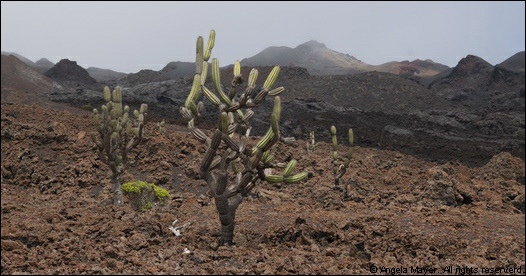
Sierra Negra

Marine Iguana
Islas Santa Cruz and Seymour
After 2 nights on Isabella, I arrived back in Santa Cruz still quite early in the day. After getting sorted at my hotel, I started heading out to to explore the town, Puerto Ayora. It is a lot bigger compared to Isabella, but I had still seen the the main part quite quickly. (They do have a lot more souvenir shops though.)
I then started heading of to a beach about an hour walking distance away from town, Playa Bahía Tortuga. You couldn't get there by car (it also wasn't really crowded there), but it is a beautiful beach, with the possibility to see lots of iguanas, lizzards, crabs and birds. As I had another trip planned for the afternoon, I didn't go swimming here, but only walked along the beach, enjoying the view, and taking photos of the animals. After about an hour, I headed back into town.
In the afternoon I was going on a snorkling trip to a spot a bit further away from town on a boat. At first we landed at a small pier, to look at the animal in this area. Landing, however, was not that easy, as a group of sea lions had occupied the pier. Only after our captain had managed to convince them to leave were we able to actually get back on land. There we waked a bit through the bizarre landscape with cactusses and iguanas, before we went snorkeling in the bay with lots of colourful fish.
In the evening, the town became quite busy, with tourists, but also with locals going for dinner or a drink. The restaurants right in the first row were manynly visited by tourist. Two streets further back, however, (I had seen that there were some small food places during the day), the whole street had turned into a big restaurant. All the little food placed on the side had put their tables down in the street, offering freshly caught fish and especially lobster, (the amount of lobster there was quite impressive,) to be cooked on the many barbeques put up on the sides.
On the next day, I had planed a day trip to visit the uninhabited (by humans) island Seymour and go snorkeling. Seymour is a small island north of Baltra (the airport island), mainly inhabited by many birds, sea lions and iguanas. The boat therefore was leaving from the north of the island, where the ferry to the airport is as well. Also at this harbour, the boat couldn't come directly to the shore. Our boat had a small dinghy (or panga) boat (which was also needed for the landings on the trip), which braught us to the main boat.
The first stop was still on Santa Cruz, a beautiful beach, Playa Las Bachas. We had a so called wet landing, meaning the dinghy got as close to the beach as possible, so that we would get out with the feet still in the water. After looking around a bit at the areas of sea turtle nests (you couldn't really see much except sand), some of us went snorkeling in the bay. Along the lava rocks, hundreds of beautiful, colourful fish were swimming, from really tiny to quite big. Time flew by, suddenly an hour was gone, and part of the group (not all had actually gone in the water) were already back on board. Just as we snorkelers had finally come out of the water, our guide finally saw a turtle in the water (what we had hope for all the time while snorkeling). We the quickly got in the dinghy, and the guide took us out the the turtle, where we jumped back in the water to shortly see and swim with the turtle close up. Finally then, very happy, we returned back to the boat.
The second stop the was on the island Seymour. There we could actually have a dry landing, meaning the dinghy brought us to some rocks, from where we could climb further up to the island. We walked around the island for about 1.5 hours, watching all the different birds nesting, breeding, mating and feeding their young. We saw fregat birds, the male trying to impress the girls with their inflated red gular pouch. Or the babies (still huge birds) waiting for their parents to return with food. Also, several blue-
On my last day on Santa Cruz, I went on a tour into the highlands of the island, to see the giant (land) turtles. The turtles like completely free, and just pass though private farms on the way to search food. On these farms then the tourists can go to watch the turtles up closely. It is quite amazing to see how the move very slowly, especially with the size and weight of their shell.
Santa Cruz, like Isabella, has been formed by volcanos (although the volcanos on Santa Cruz are not active now). Still nowadays, labs tunnels can be found at several locations, where the lava on top already solidified, but the lava on the inside was still liquid and flowed out. After spending some times with the turtles, we went to visit one of these tunnels, and went through it (at one position crawled through it).
Afterwards we spent some addational time at another beach. Here the sand of the beach was interrupted at several location by lava fields, which gave it a quite unique appearance. As I was about to catch the next ferry, once more I didn't do swimming, but 'just' enjoyed the scenery.
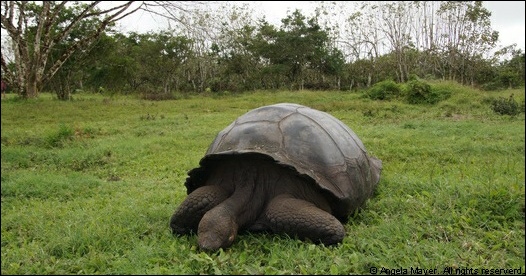
Giant Turtles on Santa Cruz

Blue-
Islas San Cristóbal and León Dormido (Kicker Rock)
In the afternoon, I took the next ferry, this time to San Cristóbal. The main town, Puerto Baquerizo Moreno, is actually the capital of the Galapagos region (although nowadays Puerto Ayora on Santa Cruz is larger and more important). Landing in San Cristóbal was a bit different for a change, as the ferry could actually dock directly at the pier, no taxi boats needed. Upon arrival, I could again directly see all the sea lions relaxing all along the waterfront, on the beach, the pier, benches, and one even in the waterslide for the kids. After checking into my hotel (quite a bit out of town, was about 5 walking minutes away from the pier), I enjoyed the last hour of sunlight for the day by walking along the waterfront and watching the sea lions.
On the next day, I was going out on the boat for a snorkeling trip again. We went to visit Kicker Rock (or León Dormido), basically just a huge rock in the sea. It is to steep and to high to actually land on the rock, but we went around it in the boat to watch the birds and sea lions living there. The main attraction, however, is under water. Along the wall of the rock (apparently more than 100 m deep), a beautiful reef had formed, with hundreds of colourful fish, sponges and starfish. In total, I spent almost two hours in the water, enjoying the reef. (After a while, the water actually started to feel quite cold, if with the wetsuit.) I did manage to see some of the seals untie water, as well as several sea turtles, who just didn't em to care that I was there. I had hoped to be able to see some (harmless) sharks in a channel between two parts of the rock, however, unfortunately, it didn't seem to be the right time for it. (Our guide also hadn't seen any, similar to the previous days, and even the divers only managed to see 2 or 3.) Luckly, however, I managed to see 3 Mola-
After warming up again a bit on board in the sun and having lunch, on the way back to the harbour, we stoped once more at a beautiful beach, back on San Cristóbal, to relax and enjoy the scenery. After arriving back in town, together with another girl from the trip, we headed out of town again (by foot), to another bay, for a little bit more snorkeling. Again, we saw sea lions, turtles, and many, many fish, but also 2 big rays. We didn't stay that long, as we wanted to be back before dark (which was somewhere around 6:15), and the water was really getting cold.
After a mice warm shower, I meat up with 2 of the other girls again, to go out for dinner, for my last night on Galapagos. We ended up in a nice restaurant at the waterfront, where (as the king prawns wee out) we had lobster in a very delicious coconut cream sauce, with rice and platacones (banana chips) (but only for the price of the king prawns).
It was a perfect last night for a wonderful time on Galapagos, but also amazing 3 weeks in Ecuador. Early on the next morning, I started heading home...
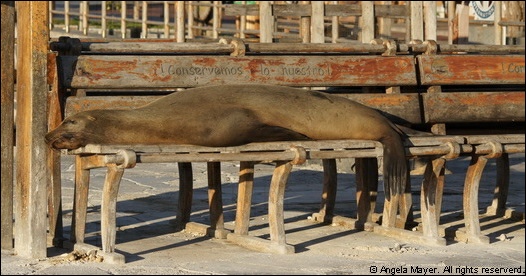
Sea Lion on San Cristobal
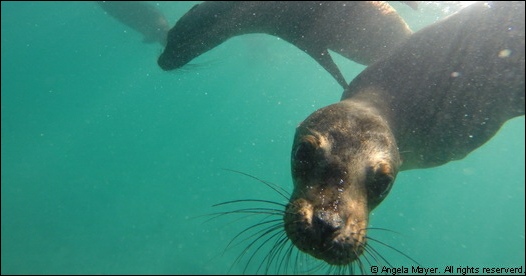
Swimming with Sea Lions

Snorkeling with Sea Turtles
Heading Home
After three weeks, I had to say goodbye to Ecuador. My last morning on San Cristóbal I had to get up quite early again to catch the ferry back to Santa Cruz. As it was just start of school holidays, it wasn't only the typical tourists taking the ferry, but it seemed like half of the island was wanting to leave as well. Because of this, it also took quite long until all people (including all their luggage) were actually 'stored' on the ferry. The ride then was accordingly uncomfortable, but after 2 hours, we finally reached Santa Cruz. (Here, all the people and luggage had to he unloaded using the taxi boats again.)
From Puerto Ayora, I was driven to the other side of the island again, took the short ferry over the canal to Baltra, and got into the (completely overcrowded) 5-
Again, the flight went via Guayaquil, and on the way back to Quito, I once more had a beautiful view on the volcanos. After an hour drive from the airport, I finally reached my hotel in Quito around 7 in the evening. I didn't really do much except for a quick dinner (I finally managed to try some guinea pig), as I was going to be picked up to head back to the airport at 5 in the morning again.
I hadn't managed to get a direct flight back to Amsterdam, so I was heading towards Mexico-
In the evening, I could finally get on my plane to Amsterdam, where we arrived about 9.5 hours later. And after a bit more waiting time, I got on the plane back to Munich.
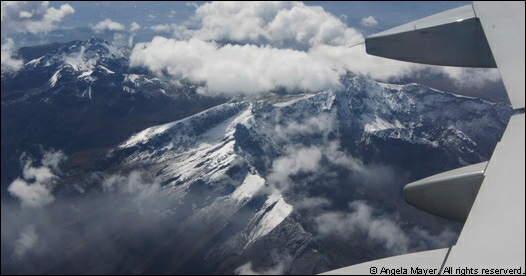
Flying along the Andes